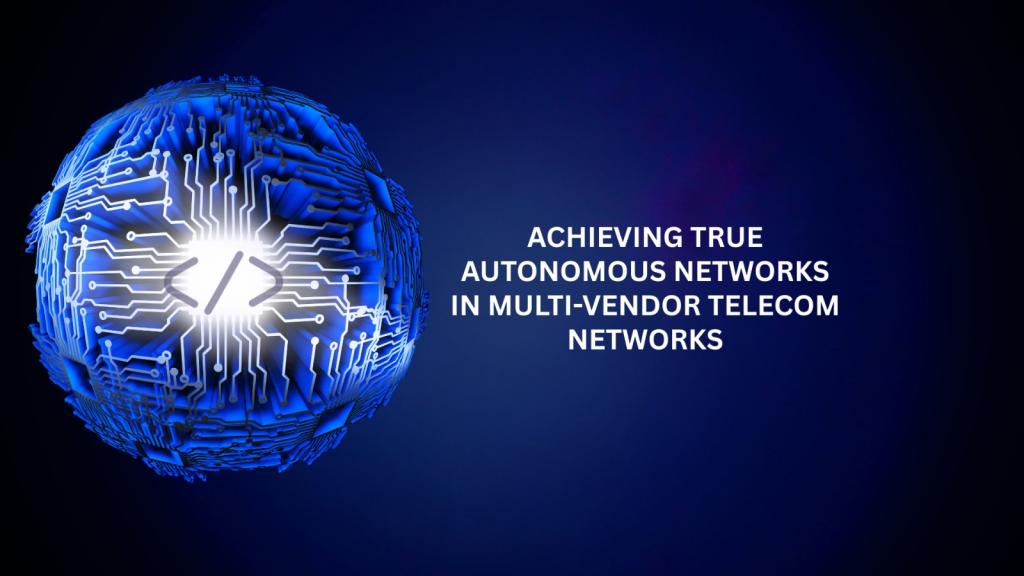Introduction: Navigating the Multi-Vendor Maze Towards Autonomous Networks
5G, IoT, and new digital services are increasing telecom network complexity, making manual management unsustainable. The industry aims for a “Zero-Touch Network” to boost customer experience, efficiency, and cut costs by minimizing human intervention and accelerating service provisioning. Telecom Network Configuration Management and Autonomous Networks, driven by AI and closed-loop automation, are vital for CSPs to manage this complexity, enabling self-management and proactive optimization.
While multi-vendor strategies offer best-of-breed technology, vendor lock-in avoidance, and cost efficiency, they also pose integration challenges. Unmanaged flexibility can increase operational complexity due to hardware incompatibilities, differing protocols, varied configurations, and disparate security models. Network disaggregation and virtualization (SDN, NFV) further complicate managing diverse vendor equipment and software.
Telecom Network Configuration Management (CM) is a core network operations discipline that offers a unified interface for cost-efficient orchestration and optimal performance. The ultimate goal is autonomous configuration management, where AI and advanced automation proactively optimize networks, moving beyond mere automation to self-governance.
The Evolution of Telecom Network Configuration Management: From Manual to Autonomous
Manual telecom network configuration, often error-prone and inefficient, impedes service deployment and scalability. Many operators, burdened by legacy infrastructure and siloed systems, face inaccurate data, delayed upgrades, budget overruns, and hindered expansion, struggling to adapt to modern telecom demands.
Zero-touch automation, powered by AI and ML, is transforming telecom by automating tasks, predicting behavior, optimizing performance, and enabling self-healing networks. This real-time, AI-driven automation is a key trend for 2025, set to revolutionize network management and service delivery.
Automation, while minimizing human intervention, evolves the role of operators; AI can’t fully replace human oversight due to the complex challenges that require human intelligence. This transition demands organizational and cultural shifts. Network engineers can enhance service quality by automating routine tasks, freeing them to concentrate on strategic planning and innovation. It requires investing in new skill sets and fostering trust in AI.
AI-driven autonomous configuration management relies on high-quality, consistent network data. Accurate data is crucial for zero-touch networks; without it, AI’s potential for predictive insights and operational efficiencies is limited. Data quality is an indispensable prerequisite for effective AI and automation in the telecom industry, as poor data can lead to erroneous autonomous decisions.
Challenges of Multi-Vendor Integration in Autonomous Networks
Integration
Multi-vendor telecom environments complicate autonomous deployments due to incompatible vendor implementations. Diverse hardware, proprietary protocols, and varying configurations hinder consistent automation and device management. Integrating disparate interfaces and frameworks leads to orchestration chaos, impeding end-to-end automation. Reliance on proprietary solutions also creates vendor lock-in, limiting operator flexibility and bargaining power.Data Reliability
Reliable data is crucial for zero-touch networks, but telecom companies often face challenges with fragmented data sources. Unified, high-quality data is essential for AI to provide predictive insights and operational efficiencies. Inaccurate data leads to suboptimal network performance, unbilled services, lost co-location opportunities, and difficulty optimizing assets.
Security Risks
Multi-vendor network infrastructures increase security risks due to flawed models, conflicting protocols, and compatibility issues. The incompatibility and weaker cybersecurity hinder performance, causing inconsistent QoS and low productivity. Autonomous networks require strict security. Cybersecurity is a critical business priority, fueled by more connected devices and frequent cyberattacks. Managing automation complexity in large, distributed networks poses a significant operational challenge.
Increasing Costs
Using multiple vendors simultaneously increases costs due to managing multiple contracts and billing systems, often proving more expensive than a single provider. Inconsistent service quality also leads to poor network performance and reduced productivity. These hidden overheads undermine multi-vendor benefits. Robust integration and automation are crucial for ROI, turning multi-vendor complexity into an advantage.

Data Reliability
Reliable data is crucial for zero-touch networks, but telecom companies often face challenges with fragmented data sources. Unified, high-quality data is essential for AI to provide predictive insights and operational efficiencies. Inaccurate data leads to suboptimal network performance, unbilled services, lost co-location opportunities, and difficulty optimizing assets.
Security Risks
Multi-vendor network infrastructures increase security risks due to flawed models, conflicting protocols, and compatibility issues. The incompatibility and weaker cybersecurity hinder performance, causing inconsistent QoS

and low productivity. Autonomous networks require strict security. Cybersecurity is a critical business priority, fueled by more connected devices and frequent cyberattacks. Managing automation complexity in large, distributed networks poses a significant operational challenge.
Increasing Costs
Using multiple vendors simultaneously increases costs due to managing multiple contracts and billing systems, often proving more expensive than a single provider. Inconsistent service quality also leads to poor network performance and reduced productivity. These hidden overheads undermine multi-vendor benefits. Robust integration and automation are crucial for ROI, turning multi-vendor complexity into an advantage.
AI in Telecom
AI adoption in telecom faces hurdles due to a lack of trust and regulatory compliance issues. This psychological, ethical, and regulatory barrier hinders the deployment of autonomous systems. Developing “explainable AI” (XAI) and robust data governance frameworks is crucial to build confidence, transparency, auditability, and compliance, thereby accelerating AI adoption in critical telecom networks.Foundational Pillars of Telecom Network Configuration Management: Data Harmonization and Common Information Models
Data harmonization is crucial for data-driven businesses, as it enables the integration of diverse datasets to ensure consistency and accuracy. In telecom, it unifies network inventory, performance, and fault data, which is essential for training AI, generating insights, and achieving operational efficiency. Without unified data, the impact of AI is limited.
Autonomous network success hinges on high-quality, harmonized data, the “fuel” for accurate AI. This vital, often underestimated, data harmonization enables seamless OSS/BSS operations like network management, accurate billing, and optimized resource allocation through a unified view. Unlike simple integration, harmonization reorganizes data into a single, consistent schema, crucial for advanced analytics and automated decision-making in telecom.
Practical strategies for unifying network data include:
Enabling Interoperability: Open Standards, APIs, and Abstraction Layers
Open APIs, especially TM Forum Open APIs, are crucial for seamless interoperability and automation in telecom, managing digital services across various domains, and enabling autonomous networks. Northbound APIs provide high-level interaction, while Southbound APIs offer granular control, abstracting complexity and boosting efficiency.
NETCONF, with YANG, standardizes network configuration, simplifying integration and maintenance in multi-vendor environments. While open YANG models are ideal, proprietary models are often more pragmatic, leading to hybrid solutions that require flexible handling.
Abstraction layers, like Kubernetes-based automation and ONAP, simplify complex networks and enhance interoperability. Intent-based networking further automates management and decouples innovation from service evolution.
Finally, “orchestration of orchestrators” or “cross-domain orchestration” is key for comprehensive multi-vendor autonomous networks, facilitating interaction between individual orchestration platforms.

Innovile’s Role in Driving Multi-Vendor Autonomous Telecom Network Configuration Management
Innovile, a leader in network automation and optimization since 2005, offers the “Zero Touch Network” vision. Their INNSPIRE Telecom Network Configuration Management (CM) provides a vendor-agnostic, unified interface, simplifying network management. INNTELLIGENT SON automates multi-vendor, multi-technology networks.
Innovile’s integrated software and services improve customer experience, operational efficiency, and cost savings for mobile network operators. Their upgraded INNSPIRE CM offers advanced automation, cloud-native compatibility, and seamless integration, aligning with 5G and digital strategies.
Innovile strategically manages multi-vendor telecom environments with proprietary solutions like INNSPIRE CM and INNTELLIGENT SON. These solutions integrate diverse vendor equipment, offering flexibility and avoiding vendor lock-in, differentiating Innovile from pure open-source alternatives.
Successful real-world deployments evidence Innovile’s capabilities:
Türk Telekom (Turkey): Innovile deployed its INTELLIGENT SON and INSPIRE CM solutions for Türk Telekom, seamlessly integrating both platforms. This streamlined NOC workflows, accelerated implementation, and optimized resource and IT infrastructure utilization, resulting in cost-effective network management. The deployment, featuring 19 SON and over 60 CM modules (including Energy Saving, Interference Management, and Load Balancing), prepared Türk Telekom for modern network complexities, including 5G, with robust automation and optimization. The Energy Saving module specifically links Innovile’s solution to sustainability by enabling efficient network configuration and reduced energy consumption, adding value beyond operational efficiency and cost savings.
Portugal: A Tier-1 mobile network operator in Portugal leveraged Innovile’s zero-touch automation capabilities to streamline the provisioning of new base stations. The automation eliminated the need for manual configuration tasks, ensuring a standardized and efficient network setup across new deployments.
Russia: A major telecom operator in Russia utilized Innovile’s zero-touch automation for rapid configuration updates during frequent network upgrades and changes. The feature enabled swift and seamless updates across the entire network, significantly reducing the risks of disruption and downtime.
The Future of Autonomous Networks: Beyond 5G and Towards Cognitive Operations
The telecom industry is moving towards Level 4 autonomous networks, aiming for minimal human intervention. Constant learning in autonomous systems is essential for agents to enhance accuracy, performance, and efficiency through operational experience.
Closed-loop automation, leveraging real-time feedback, enables self-healing and performance optimization with minimal human intervention. AI-driven Self-Organizing Networks (SON) are transforming telecom automation through self-configuration, self-optimization, and self-healing, allowing dynamic network adaptation. The goal is a new kind of network: decentralized, autonomous, and intelligent by design, capable of continuous learning.
Network management is evolving from basic automation to AI-driven autonomy, a fundamental shift where networks learn, reason, and adapt independently, enabling proactive, self-governing operations. This transformation relies on the synergy between open standards and AI. AI provides intelligence, while open standards offer structure, interoperability, and a common language, crucial for AI to operate effectively across complex, multi-vendor environments. Without standardization, AI’s potential would be limited to isolated domains.
Conclusion: Unlocking the Full Potential of Telecom Networks
Autonomous configuration management in telecom networks thrives on data harmonization, open standards (NETCONF/YANG, TM Forum Open APIs), and vendor-agnostic solutions like Innovile. It ensures unified AI data, interoperability, and flexibility, avoiding vendor lock-in.
Autonomous networks boost efficiency, reducing OPEX/CAPEX, and enhance customer experience through seamless, fast, reliable, personalized services. They accelerate time-to-market and free engineers for strategic tasks.
Telecom operators must embrace autonomous networks to avoid becoming mere utilities. This proactive shift offers efficiency, cost reduction, a better customer experience, faster innovation, new revenue streams, and a competitive edge. Autonomous network configuration management is vital for survival and growth.
Successful automation requires a holistic shift in skills, methods, and technology—people, processes, and technology. MNOs should prioritize data quality, open ecosystems, and multi-vendor solutions. Innovile, with its robust, vendor-agnostic solutions and services (Managed Services, Smart Projects, Consulting), is a proven partner for this holistic transformation.

